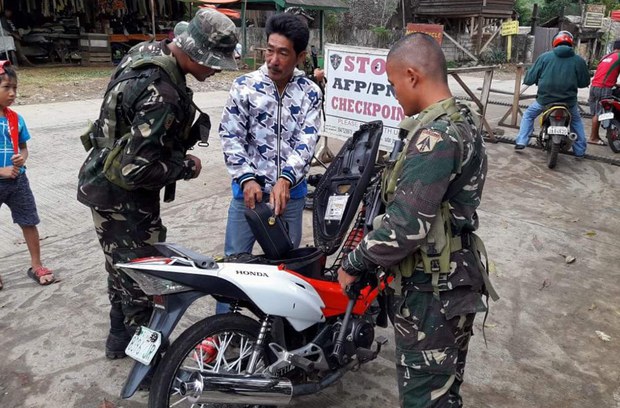Philippines Military Investigates Reports of Second Bomb
2018.08.03
Lamitan and Cotabato, Philippines
 Military personnel check a motorcycle at a road block entering the town of Lamitan in the southern Philippines, Aug. 2, 2018.
Military personnel check a motorcycle at a road block entering the town of Lamitan in the southern Philippines, Aug. 2, 2018.
The Philippine military is looking into unverified reports that the Abu Sayyaf Group (ASG) deployed a second van containing explosives similar to the one that killed 10 on the island of Basilan this week.
Regional military chief Lt. Gen. Arnel Dela Vega said the military had heard reports of the new bomb, and while the army could not confirm immediately, officers were not discounting them.
“All possibilities, all indicators that would suggest [that this were true], we are looking at all of that just to ensure that it won’t happen again,” Dela Vega told reporters on Friday in Zamboanga city, just across the strait from Basilan.
Dela Vega said troops and police were targeting persons of interest though he did not divulge details.
Merchants were told to look out for anyone purchasing suspicious amounts of ammonium nitrate or other chemicals that could be used to make bombs, he said. The chemical is used to make fertilizer and is readily available in agricultural areas in the south.
Military officials said about 40 to 50 kilos of ammonium nitrate with two gallons of gasoline and oil were used in Tuesday’s bombing that killed 10 including the driver of a van ferrying the bomb.
The blast occurred at a road block outside Lamitan, a mixed Muslim-Christian city in Basilan where security has been tight to prevent ASG militants from carrying out attacks.
Police arrested a 58-year-old Muslim cleric who allegedly had ties to the bomber. The Islamic State (IS) identified the bomber as a Moroccan operative, a claim that security analysts said was highly likely even as the military expressed caution about the bomber’s identity.
The SITE Intelligence Group, citing the IS’ Amaq news, identified the bomber as Moroccan Abu Kathir al-Maghribi.
In Manila, presidential spokesman Harry Roque said authorities were investigating and verifying whether the bombing was carried out by IS.
“I would not jump to any conclusion. So far we know that there has been a local cleric who has been ordered arrested,” Roque told reporters. “We know that it exploded in a vehicle and that it killed both passengers and those manning the checkpoint.”
He said enforcement agencies were expected to issue a final investigation report identifying the bomber.
“We are still not verifying that this was an ISIS attack. Authorities are still investigating. It’s very easy to claim credit for a foreign attack,” Roque said, using another acronym for the Islamic State group.
Military intelligence sources earlier said the blast could have been directed by Mike Lijal, believed to be one of the aides of Furuji Indama (alias Abu Dujanah), ASG’s Basilan commander.
Indama took the ASG reins from Isnilon Hapilon, the acknowledged IS commander in the south who led a combat force that occupied the southern city of Marawi city last year.
Hapilon was killed in October, effectively ending the five-month siege that left 1,200 people dead and Marawi in shambles.
While the government appears to be treading carefully about the IS angle, security analysts said Philippine military officials should take the claim seriously instead of deflecting criticism away from internal security lapses.
ASG, founded in the early 1990s, is notorious for kidnappings, bombings and beheadings in southern Philippines over the past two decades.
The group was blacklisted by the United States as a foreign terrorist organization. It continues to hold several foreigners and Filipinos hostage after beheading a German captive and two Canadian hostages in the past two years.
Military spokesman Col. Edgard Arevalo urged the public to trust security forces, saying that the armed forces could use all its resources to crush the militants.
He cautioned against readily accepting the IS claim to the Basilan bombing, noting it could have been an extortion attempt by ASG that went awry.







